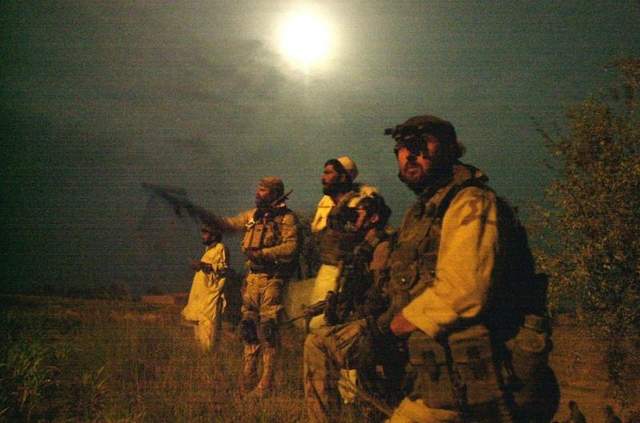FORT BRAGG, N.C. — They were the first Americans into Afghanistan after the Sept. 11 attacks and will probably be the last U.S. forces to leave.
As most American troops prepare to withdraw in 2014, the CIA and military special operations forces to be left behind are girding for the next great pivot of the campaign, one that could stretch their war up to another decade.

Members of the U.S. Army Special Forces keep close eye on the moon-lit perimeter of a compound, suspected of holding al-Qaida and Taliban forces, in August in Narizah, east of Kabul, Afghanistan. The units will stay in Afghanistan to fight terrorists. / FILE / AP
The war’s 10th anniversary Friday recalled the beginnings of a conflict that drove the Taliban from power and lasted far longer than was imagined.
“We put a CIA guy in first,” scant weeks after the twin towers in New York fell, said Lt. Gen. John Mulholland, then a colonel with U.S. special operations forces, in charge of the military side of the operation. U.S. Special Forces Green Berets, together with CIA officers, helped coordinate anti-Taliban forces on the ground with U.S. firepower from the air, to topple the Taliban and close in on al-Qaida.
Recent remarks from the White House suggest the CIA and special operations forces will be hunting al-Qaida and working with local forces long after most U.S. troops have left.
When Afghan troops take the lead in 2014, “the U.S. remaining force will be basically an enduring presence force focused on counterterrorism,” said National Security Advisor Tom Donilon, in remarks in Washington in mid-September. That will be augmented by teams that will continue to train Afghan forces, added White House spokesman Tommy Vietor.
The White House insists this does not mean abandoning the strategy of counterinsurgency, in which large numbers of troops are needed to keep the population safe. It simply means replacing the surge of 33,000 U.S. troops, as it withdraws over the next year, with newly trained Afghan ones, according to senior White House Afghan war adviser Doug Lute.
An increased role
It also means U.S. special operators and CIA officers will be there for the next turn in the campaign. That’s the moment when Afghans will either prove themselves able to withstand a promised Taliban resurgence, or find themselves overwhelmed by seasoned Taliban fighters.
“We’re moving toward an increased special operations role,” together with U.S. intelligence, Mulholland said, “whether it’s counterterrorism-centric, or counterterrorism blended with counterinsurgency.”
As outgoing head of U.S. Army Special Operations Command, Mulholland has been in charge of feeding a steady stream of troops to commanders in the field. He knows they need as many special operations troops as he can produce and send. Those special operations forces under his command include U.S. Army Rangers, known for their raiding operations against militant targets, and U.S. Special Forces Green Berets, whose stock in trade is teaching local forces to fight a common enemy so the U.S. doesn’t have to.
A foundation for special-operations-style counterinsurgency is already under way — staffed primarily by the Green Berets — with the establishment of hundreds of sites in remote Afghan villages where the U.S. troops are paired with Afghan local tribesmen trained by the Americans, Mulholland explained.
The program has been so successful in the eyes of NATO commanders that they’ve assigned other special operators like Navy SEALs to the mission, and even paired elite troops with conventional forces to stretch the numbers and cover more territory.
Senior U.S. officials have spoken of keeping a mix of 10,000 of both raiding and training special operations forces in Afghanistan, and drawing down to between 20,000 and 30,000 conventional forces to provide logistics and support. But at this point, the figures are as fuzzy as the future strategy.
Whatever happens with U.S. troops, intelligence officers know they will be a key component.
“If the CIA built an intelligence network that could provide special operations forces with targets, we could do the job,” said Maj. Gen. Bennet S. Sacolick, who runs the U.S. Army’s Special Warfare Center and School.
The other branch of special operations — the Green Berets and others Mulholland mentioned who specialize in training — would continue to support the Afghans in remote locations, trying to keep the Taliban from spreading.
The notion of a pared-down U.S. fighting force, consisting of a latticework of intelligence and special operators, plus the far-flung units in the field, has spurred some criticism on Capitol Hill.
“You cannot protect the United States’ safety with counterterrorism waged from afar,” said Rep. Mac Thornberry, R-Texas, chairman of the House Armed Services Committee’s emerging threats panel
http://www.tennessean.com/article/20111009/NEWS/310090061/Special-units-CIA-keep-waging-war

